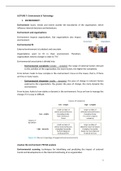LECTURE 7: Environment & Technology
1. ENVIRONMENT:
Environment issues, trends and events outside the boundaries of the organization, which
influence internal decisions and behaviours.
Environment and organizations:
Environment impacts organizations. But organizations also impact
environment.
Environmental fit:
External environment is turbulent and uncertain.
Organizations want to fit in their environment. Therefore,
organizations need to change in order to “fit”.
Environmental uncertainty is divided into:
- Environmental complexity (simple – complex): the range of external factors relevant
to the activities of the organization; the more factors, the higher the complexity.
From lecture: looks to how complex is the environment. Focus on the issues, that is, if there
are few or many issues.
- Environmental dynamism (stable – dynamic): the pace of change in relevant factors
external to the organization; the greater the pace of change, the more dynamic the
environment.
From lecture: looks to how stable or dynamic is the environment. Focus on how to manage the
change, if it is easy or difficult.
Analyse the environment: PESTLE analysis
Environmental scanning: techniques for identifying and predicting the impact of external
trends and developments on the internal functioning of an organization.
1
, PESTLE analysis: an environmental scanning tool identifying Political, Economic, Social,
Technological, Legal and Ecological factors that affect an organization.
The PESTLE analysis looks at six components:
- Political: includes some governmental policy, political stability, taxation, industry
regulations, global trade agreements, uncertainty on leaving the EU, etc.
Example: with the UK Brexit, lots of people left their jobs and firms moved away from the UK.
It’s a political factor affecting organizations.
- Economic: includes exchange rates, globalization, economic growth (or decline),
inflation and interest rates, cost of living, labour costs, etc.
- Social: looks at the consumers’ spending habits, fashions, lifestyles, work and career
attitudes, work-life balances, demographic trends, etc.
Example: the fact that there number of ancient population is growing more than young people
has an impact in organizations, as we will see later on.
- Technological: looks at the development of technology, compares how organizations
function now and how they functioned in the past, robotics, artificial intelligence,
automation, social networking, security, etc. (still evolving, as we will see at the end of
this lecture).
Example: Kodak did not pay attention to this technological aspect when digital cameras came
out and this was the reason of its bankruptcy.
- Legal: legislature issues, general and employment law and its changes, common law,
health and safety regulations.
Example: there are laws forcing organizations to charge money for plastic bags in order to
diminish plastic waste.
- Ecological: environmental restrictions, sustainable and ethical resourcing, CSR,
transportation, gas emissions, supply chain management, etc.
Example: moving the production to a country with low ecological regulations.
Strengths of PESTLE:
o The focus is on the big picture: identifying the range of external factors
affecting internal organizational arrangements and business planning.
o Convenient framework to plan for future opportunities and threats.
Weaknesses of PESTLE:
o It may identify non-significant factors: the analysis may identify many factors
which may not be significant. It is difficult to strike a balance between
identifying all factors, and focusing on those which are important.
o Some events are difficult to anticipate: it is difficult to anticipate ‘defining
events’, such as wars, terrorist attacks, new discoveries, economic collapse,
and major political or financial crises which shift country boundaries or
radically change government policies. Unpredictable events: Covid-19
pandemic, wars or terrorist attacks.
2




